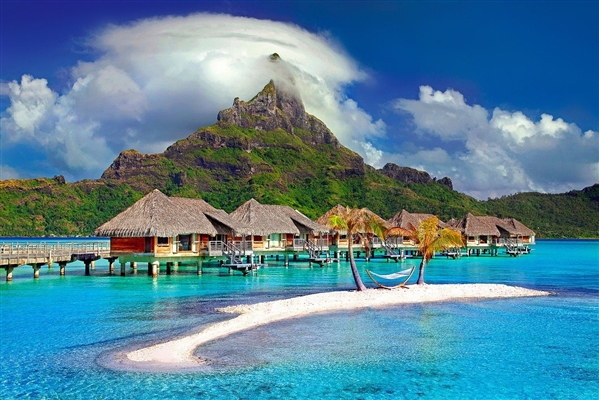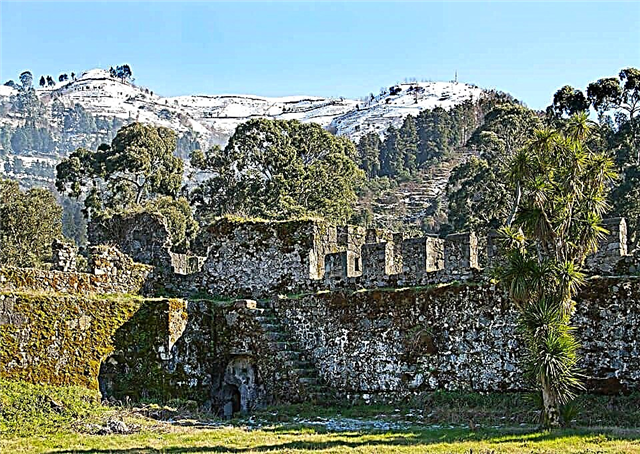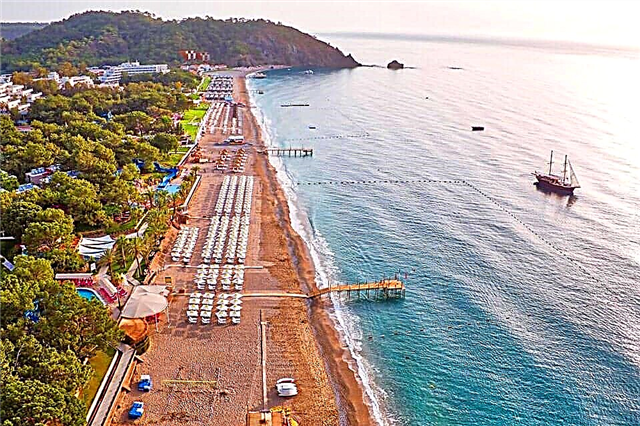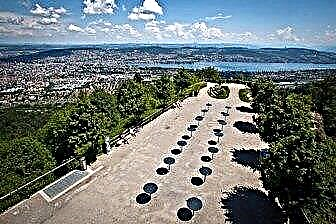Almost impeccable cleanliness of the streets, cold restraint, high standards and standard of living - all this can be found in Zurich, which stretches along the banks of the Limmat River. In this city, it seems, the spirit of the age-old order and a long-established respectable way of life soars.
The architecture in the historical part of Zurich is not distinguished by luxury - everything here serves practicality and rationality. The millennial facades of the Fraumünster and Grossmünster cathedrals amaze with their monumentality, but not splendor, the stone paving stones of the squares are in harmony with the beauty of the Bahnhofstrasse facades, and world destinies are decided behind the closed doors of Swiss banks.
Zurich doesn't need to flaunt itself. In this city, you can feel the power and boundless wealth that hides behind the walls of obscenely expensive boutiques, watch shops and modest facades of residential areas.

The best hotels and hotels at affordable prices.
from 500 rubles / day
What to see and where to go in Zurich?
The most interesting and beautiful places for walking. Photos and a short description.
Old city
The architectural appearance of the historical center of Zurich - the Altstadt district, took shape over several centuries and finally took shape by the end of the 19th century. The old town is located on the banks of the Limmat River, it includes the quarters Hochschulen, Rathaus, Lindenhof. The main churches of Zurich and medieval mansions are concentrated in the historic district. Some of the Altstadt buildings date back to the 11th century.

Paradeplatz square
The business center of Zurich, where the offices of world famous Swiss banks, boutiques of watch brands, designer showrooms, jewelry stores, hotels are located, with a beautiful view of the lake. Thanks to its convenient infrastructure, this place is considered the best (and one of the most expensive) for shopping. Paradeplatz is also famous for its large number of pastry shops, where delicious pastries and cakes are made.

Bürkliplatz square
The square is located at Lake Zurich, one of the central streets, Bahnhofstrasse, abuts against it. At Bürklipplatz there is a convenient observation deck from where you can admire the impeccable water surface of Lake Zurich surrounded by the Alps. There is also a pier from which pleasure boats depart. The square is decorated with a sculptural fountain "Geyser", created at the beginning of the XX century.

Langstrasse street
Even such a respectable city as Zurich has its "hot spots". They are mainly located on Langstrasse. This is the local "red light district" with an abundance of entertainment establishments, bars, brothels. The Langstrasse area is home to a large number of immigrants. It hosts the annual Langstrassefest street music festival, with all the surrounding areas having fun.

Bahnhofstrasse
The alley, which starts at the city's central station and ends at Lake Zurich, is about 1.5 km long. The street runs on the site of the old fortress walls and separates the historic part of Zurich from the modern quarters. Bahnhofstrasse is one of the best places for shopping, walking and exploring the respectable life of the city. There are many five star hotels and expensive restaurants here.

Grossmünster
The cathedral is located on the banks of the Limmat River, its gray towers are clearly visible from all the central districts of Zurich. The temple was built in a gloomy Romanesque style. It is believed that its history began in the 9th century and is associated with the name of the Emperor Charlemagne. His horse fell to his knees in front of the grave of the Christian martyrs Felix and Regula, who fled from the persecution of the Romans. The brother and sister were executed and buried on the hill, where the Grossmünster was later erected.

Fraumünster Church
According to the surviving documents, the temple was erected in the 9th century under Louis II for his daughter Hildegarda, who preferred monasticism to secular life. For a long time, there was a nunnery at the church, where representatives of noble families were tonsured. The monastery had great influence and even minted its own coin, but by the beginning of the 16th century it had lost its power and was dissolved. Until the middle of the 20th century, the Fraumünster church fell into decay, but in the 60s. has been restored. The artist M. Chagall worked on the stained-glass windows.

St. Peter's Church
Temple of the IX century with an ancient tower clock with a 4-meter minute hand and a dial diameter of about 9 meters. The church was built on the foundations that have survived from the 8th century. In the 13th century, the building was rebuilt in the Gothic style, and in 1706 it acquired its modern appearance. Part of the temple premises is owned by the city, the other part belongs to the Swiss Reform Church.

Rietberg Museum
An extensive museum collection is housed in 3 buildings - Villa Wesendok, Villa Rieters, and the Kiel House mansion, where temporary exhibitions are regularly held. The main theme of the exposition is the history of non-European cultures. The museum exhibits exhibits brought from Asia, Oceania, America and Africa. The German banker Van der Heidt made a great contribution to the replenishment of the museum funds.

Kunsthaus
City Art Gallery, which contains works by P. Fischli, I. Fusli, D. Alberto, R. Pipilotti, E. Munch, E. Manet and other masters. Some tourists come to Zurich specifically to visit the Kunsthaus, as the museum's collection is valued all over the world. In addition to famous paintings by world-renowned artists, you can see interesting works of Swiss masters here.

Swiss National Museum
The museum is located in the city center on the territory of a real castle with severe walls and watchtowers. The exposition acquaints visitors with the history of Switzerland from ancient times to the present day. Here are collected artifacts of the Stone Age, household items and art of the early Middle Ages, unique knightly armor, clothing, weapons and other items. A separate collection is dedicated to the history of Swiss watches.

Beyer Watch Museum
The museum operates at the Beyer Chronometri watch shop. The collection contains over 500 pieces that tell the story of the most prestigious and expensive brands of Swiss watch movements. Here you will find precise quartz movements, old chronometers, modern models, as well as very ancient exhibits that were used to measure time many centuries ago.

FIFA Football Museum
The modern museum of the history of football, a real "paradise" for fans of this game. The collection consists of cups, banners, photographs, documents, player uniforms that FIFA has been collecting since 1930. Here you can see landmark exhibits from the world championships and unique snapshots of the most exciting moments of the game. On the ground floor of the building where the collection is located, there is a sports bar for visitors.

Zurich Opera House
The magnificent opera house is located near Lake Zurich. It was built at the end of the 19th century and restored in 1984. R. Wagner played a tangible role in the formation and development of the scene. The theater is distinguished by a large number of bold interpretations of classical operas, which may appeal to connoisseurs of everything new and progressive, but frighten off fans of tradition.

Town hall
The town hall building was erected in the 17th century near the Grossmünster Cathedral in the Old Town. The building is a symbol of the well-being of the city, measured and orderly lifestyle of people.The town hall is built in a restrained baroque style, but the interior is distinguished by luxury and a lot of decorative finishes. From the inside, the town hall looks more like a palace than a meeting room of the city authorities.

Urania Observatory
The observatory has been operating since 1907, providing an opportunity for everyone to admire the stars. It is equipped with a powerful 20-ton Zeiss telescope. In addition to contemplating distant worlds, from under the dome of the observatory you can look at the panorama of the city, the magnificent Alps and Lake Zurich. The observatory has a variety of educational and entertainment programs, some of which are specially designed for children.

Zurich train station
The transport hub connects Zurich with other Swiss cantons, as well as Italy, France, Germany and Austria. The paths are laid through the picturesque mountainous terrain, while the train travels you can admire the alpine meadows, peaks and lakes. The station is located at the beginning of the main "artery" of the city - Bahnhofstrasse. The modern building was built in 1871 according to the design of J.F. Wanner.

Funicular Polyban
A historic lift that began operating in 1889. It was created for the students of the University of Zurich who are forced to climb a steep hill every day from the embankment of the Limmat River to the doors of the educational institution. Over time, it has developed into a tourist attraction. In the 70s. XX century, the service company of the funicular went bankrupt, the structure was taken under the tutelage of the Swiss bank USB.

Zurich zoo
The zoo covers an area of more than 11 thousand square meters and is one of the largest, comfortable and modern in Europe. According to common practice, the space is divided into thematic zones, in which animals from similar climatic conditions are placed in groups. Here are the ecosystems of the rainforest, Antarctica, savannah and others. There is even a makeshift agricultural farm.

Old botanical garden
The garden was created in 1833 at the University of Zurich with the assistance of the physician and naturalist I. Gesner. Now it is considered "old", since in 1976 another garden was organized, which is also run by the educational institution. The Old Garden is home to unique trees planted by Gesner, as well as many medicinal shrubs and herbs that have been known since the Middle Ages. There is a monument in honor of the founder in the park.

Chinese Garden in Zurich
The park is a gift to Zurich from the Chinese sister city of Kunming. The garden is located in close proximity to the shores of Lake Zurich. Among the restrained Swiss luxury, this corner of the East with bridges, pagodas, and figurines of mythological characters looks especially bright. The garden is home to bamboo, pines and a special kind of cherry, adapted to local climatic conditions.

Lindenhof
The city quarter, which is part of the historic part of Zurich and is located on a hilly coast, from where the surroundings are perfectly visible. On the territory of the district there is one of the best viewing platforms in the city at an altitude of 25 meters above the river level. From this point, it seems as if the city stretches out at its very feet, and excellent panoramic photos are obtained here. In the Middle Ages, archery competitions were held on the top of the hill.

Limmat river
The main waterway of Zurich, dividing the city in two. It originates in Lake Zurich and carries its blue and clear waters through several settlements. The total length of the river is about 30 km. The Limmat waterfront within Zurich is home to many attractions and recreational walking areas. In the waters of the river, swans have found refuge, which locals are happy to feed.

Zurich lake
A picturesque reservoir, on the banks of which Zurich, Maylen, Lachen, Yona and other settlements are located. It is entangled in a network of railways and highways. River cruises are popular with tourists, although a car ride around the lake is just as enjoyable. From the Bürkliplatz square in Zurich, you can admire the peaks of the Alps, reflected on the water surface of the lake.

Mount Uetliberg
A regular train runs to the mountain from the city station. There is an observation deck at the top, which can be reached by a gravel road. The journey takes about 10 minutes. The slopes of the mountain are a landscaped park equipped with paths and ramps. It is pleasant to visit it in any season - both summer and winter. From the top of the mountain there is a view of the city and the alpine valleys, and the local TV tower is also located here.












